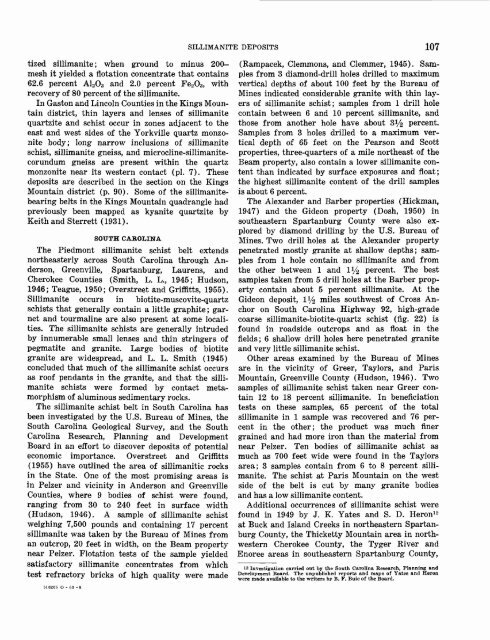Kyanite, Sillimanite, and Andalusite Deposits of the Southeastern ...
Kyanite, Sillimanite, and Andalusite Deposits of the Southeastern ...
Kyanite, Sillimanite, and Andalusite Deposits of the Southeastern ...
You also want an ePaper? Increase the reach of your titles
YUMPU automatically turns print PDFs into web optimized ePapers that Google loves.
SILLIMANITE DEPOSITS 107<br />
tized sillimanite; when ground to minus 200-<br />
mesh it yielded a flotation concentrate that contains<br />
62.6 percent A12O3 <strong>and</strong> 2.0 percent Fe2O3, with<br />
recovery <strong>of</strong> 80 percent <strong>of</strong> <strong>the</strong> sillimanite.<br />
In Gaston <strong>and</strong> Lincoln Counties in <strong>the</strong> Kings Mountain<br />
district, thin layers <strong>and</strong> lenses <strong>of</strong> sillimanite<br />
quartzite <strong>and</strong> schist occur in zones adjacent to <strong>the</strong><br />
east <strong>and</strong> west sides <strong>of</strong> <strong>the</strong> Yorkville quartz monzonite<br />
body; long- narrow inclusions <strong>of</strong> sillimanite<br />
schist, sillimanite gneiss, <strong>and</strong> microcline-sillimanitecorundum<br />
gneiss are present within <strong>the</strong> quartz<br />
monzonite near its western contact (pi. 7). These<br />
deposits are described in <strong>the</strong> section on <strong>the</strong> Kings<br />
Mountain district (p. 90). Some <strong>of</strong> <strong>the</strong> sillmianitebearing<br />
belts in <strong>the</strong> Kings Mountain quadrangle had<br />
previously been mapped as kyanite quartzite by<br />
Keith <strong>and</strong> Sterrett (1931).<br />
SOUTH CAROLINA<br />
The Piedmont sillimanite schist belt extends<br />
nor<strong>the</strong>asterly across South Carolina through Anderson,<br />
Greenville, Spartanburg, Laurens, <strong>and</strong><br />
Cherokee Counties (Smith, L. L., 1945; Hudson,<br />
1946; Teague, 1950; Overstreet <strong>and</strong> Griffitts, 1955).<br />
<strong>Sillimanite</strong> occurs in biotite-muscovite-quartz<br />
schists that generally contain a little graphite; garnet<br />
<strong>and</strong> tourmaline are also present at some localities.<br />
The sillimanite schists are generally intruded<br />
by innumerable small lenses <strong>and</strong> thin stringers <strong>of</strong><br />
pegmatite <strong>and</strong> granite. Large bodies <strong>of</strong> biotite<br />
granite are widespread, <strong>and</strong> L. L. Smith (1945)<br />
concluded that much <strong>of</strong> <strong>the</strong> sillimanite schist occurs<br />
as ro<strong>of</strong> pendants in <strong>the</strong> granite, <strong>and</strong> that <strong>the</strong> sillimanite<br />
schists were formed by contact metamorphism<br />
<strong>of</strong> aluminous sedimentary rocks.<br />
The sillimanite schist belt in South Carolina has<br />
been investigated by <strong>the</strong> U.S. Bureau <strong>of</strong> Mines, <strong>the</strong><br />
South Carolina Geological Survey, <strong>and</strong> <strong>the</strong> South<br />
Carolina Research, Planning <strong>and</strong> Development<br />
Board in an effort to discover deposits <strong>of</strong> potential<br />
economic importance. Overstreet <strong>and</strong> Griffitts<br />
(1955) have outlined <strong>the</strong> area <strong>of</strong> sillimanitic rocks<br />
in <strong>the</strong> State. One <strong>of</strong> <strong>the</strong> most promising areas is<br />
in Pelzer <strong>and</strong> vicinity in Anderson <strong>and</strong> Greenville<br />
Counties, where 9 bodies <strong>of</strong> schist were found,<br />
ranging from 30 to 240 feet in surface width<br />
(Hudson, 1946). A sample <strong>of</strong> sillimanite schist<br />
weighing 7,500 pounds <strong>and</strong> containing 17 percent<br />
sillimanite was taken by <strong>the</strong> Bureau <strong>of</strong> Mines from<br />
an outcrop, 20 feet in width, on <strong>the</strong> Beam property<br />
near Pelzer. Flotation tests <strong>of</strong> <strong>the</strong> sample yielded<br />
satisfactory sillimanite concentrates from which<br />
test refractory bricks <strong>of</strong> high quality were made<br />
510Z05 O - 60 -8<br />
(Rampacek, Clemmons, <strong>and</strong> Clemmer, 1945). Samples<br />
from 3 diamond-drill holes drilled to maximum<br />
vertical depths <strong>of</strong> about 100 feet by <strong>the</strong> Bureau <strong>of</strong><br />
Mines indicated considerable granite with thin layers<br />
<strong>of</strong> sillimanite schist; samples from 1 drill hole<br />
contain between 6 <strong>and</strong> 10 percent sillimanite, <strong>and</strong><br />
those from ano<strong>the</strong>r hole have about 31/2 percent.<br />
Samples from 3 holes drilled to a maximum vertical<br />
depth <strong>of</strong> 65 feet on <strong>the</strong> Pearson <strong>and</strong> Scott<br />
properties, three-quarters <strong>of</strong> a mile nor<strong>the</strong>ast <strong>of</strong> <strong>the</strong><br />
Beam property, also contain a lower sillimanite content<br />
than indicated by surface exposures <strong>and</strong> float;<br />
<strong>the</strong> highest sillimanite content <strong>of</strong> <strong>the</strong> drill samples<br />
is about 6 percent.<br />
The Alex<strong>and</strong>er <strong>and</strong> Barber properties (Hickman,<br />
1947) <strong>and</strong> <strong>the</strong> Gideon property (Dosh, 1950) in<br />
sou<strong>the</strong>astern Spartanburg County were also explored<br />
by diamond drilling by <strong>the</strong> U.S. Bureau <strong>of</strong><br />
Mines. Two drill holes at <strong>the</strong> Alex<strong>and</strong>er property<br />
penetrated mostly granite at shallow depths; samples<br />
from 1 hole contain no sillimanite <strong>and</strong> from<br />
<strong>the</strong> o<strong>the</strong>r between 1 <strong>and</strong> IVa percent. The best<br />
samples taken from 5 drill holes at <strong>the</strong> Barber property<br />
contain about 5 percent sillimanite. At <strong>the</strong><br />
Gideon deposit, iVa miles southwest <strong>of</strong> Cross Anchor<br />
on South Carolina Highway 92, high-grade<br />
coarse sillimanite-biotite-quartz schist (fig. 22) is<br />
found in roadside outcrops <strong>and</strong> as float in <strong>the</strong><br />
fields; 6 shallow drill holes here penetrated granite<br />
<strong>and</strong> very little sillimanite schist.<br />
O<strong>the</strong>r areas examined by <strong>the</strong> Bureau <strong>of</strong> Mines<br />
are in <strong>the</strong> vicinity <strong>of</strong> Greer, Taylors, <strong>and</strong> Paris<br />
Mountain, Greenville County (Hudson, 1946). Two<br />
samples <strong>of</strong> sillimanite schist taken near Greer contain<br />
12 to 18 percent sillimanite. In beneficiation<br />
tests on <strong>the</strong>se samples, 65 percent <strong>of</strong> <strong>the</strong> total<br />
sillimanite in 1 sample was recovered <strong>and</strong> 76 percent<br />
in <strong>the</strong> o<strong>the</strong>r; <strong>the</strong> product was much finer<br />
grained <strong>and</strong> had more iron than <strong>the</strong> material from<br />
near Pelzer. Ten bodies <strong>of</strong> sillimanite schist as<br />
much as 700 feet wide were found in <strong>the</strong> Taylors<br />
area; 3 samples contain from 6 to 8 percent sillimanite.<br />
The schist at Paris Mountain on <strong>the</strong> west<br />
side <strong>of</strong> <strong>the</strong> belt is cut by many granite bodies<br />
<strong>and</strong> has a low sillimanite content.<br />
Additional occurrences <strong>of</strong> sillimanite schist were<br />
found in 1949 by J. K. Yates <strong>and</strong> S. D. Heron12<br />
at Buck <strong>and</strong> Isl<strong>and</strong> Creeks in nor<strong>the</strong>astern Spartanburg<br />
County, <strong>the</strong> Thicketty Mountain area in northwestern<br />
Cherokee County, <strong>the</strong> Tyger River <strong>and</strong><br />
Enoree areas in sou<strong>the</strong>astern Spartanburg County,<br />
12 Investigation carried out by <strong>the</strong> South Carolina Research, Planning <strong>and</strong><br />
Development Board. The unpublished reports <strong>and</strong> maps <strong>of</strong> Yates <strong>and</strong> Heron<br />
were made available to <strong>the</strong> writers by B. F. Buie <strong>of</strong> <strong>the</strong> Board.
















